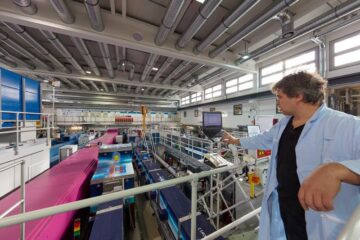Molecular Glue

Pyrococcus furiosus (“rushing fireball”) was named for the ability of this archaeal coccus to rapidly swim at its optimal growth temperature, around 100°C. Early electron microscopic studies identified up to 50 cell surface appendages originating from one pole of the coccus, which have been called flagella. Scientists of the University of Regensburg found that P. furiosus cells could adhere via their flagella to carbon-coated gold grids used for electron microscopic analyses, to sand grains collected from the original habitat and to various other surfaces. P. furiosus grew
on surfaces in biofilm-like structures, forming microcolonies with cells interconnected by flagella and adhering to the solid supports. Therefore, they concluded that P. furiosus probably uses flagella for swimming but that the cell surface appendages also enable this archaeon to form cable-like cell-cell connections and to adhere to solid surfaces. The invention describes the genetic engineering of the molecular structure of the flagellum for the biotechnological production of a molecular glue for many purposes.
Weitere Informationen: PDF
Bayerische Patentallianz GmbH
Tel.: +49 89 5480177-0
Ansprechpartner
Peer Biskup
Media Contact
Alle Nachrichten aus der Kategorie: Technologieangebote
Neueste Beiträge

Bakterien für klimaneutrale Chemikalien der Zukunft
Forschende an der ETH Zürich haben Bakterien im Labor so herangezüchtet, dass sie Methanol effizient verwerten können. Jetzt lässt sich der Stoffwechsel dieser Bakterien anzapfen, um wertvolle Produkte herzustellen, die…

Batterien: Heute die Materialien von morgen modellieren
Welche Faktoren bestimmen, wie schnell sich eine Batterie laden lässt? Dieser und weiteren Fragen gehen Forschende am Karlsruher Institut für Technologie (KIT) mit computergestützten Simulationen nach. Mikrostrukturmodelle tragen dazu bei,…

Porosität von Sedimentgestein mit Neutronen untersucht
Forschung am FRM II zu geologischen Lagerstätten. Dauerhafte unterirdische Lagerung von CO2 Poren so klein wie Bakterien Porenmessung mit Neutronen auf den Nanometer genau Ob Sedimentgesteine fossile Kohlenwasserstoffe speichern können…

















